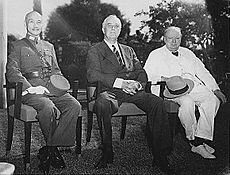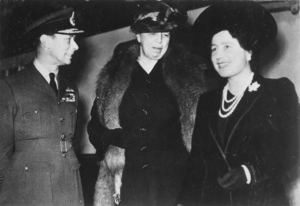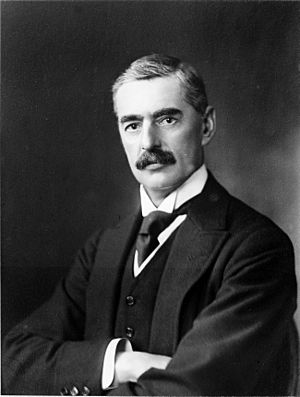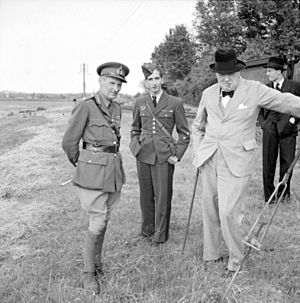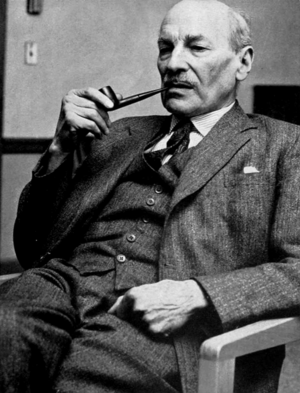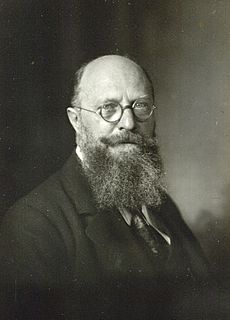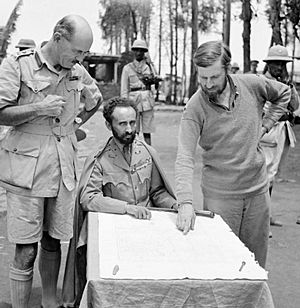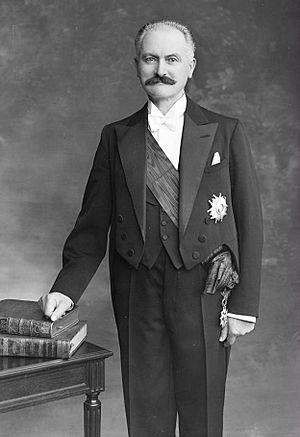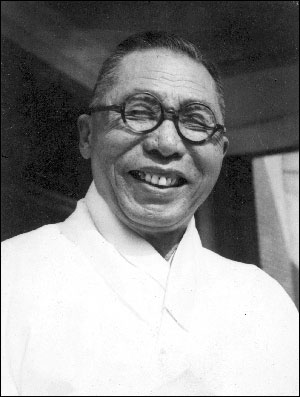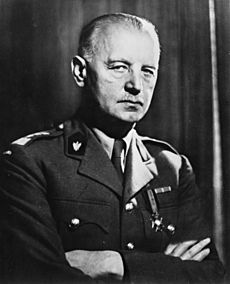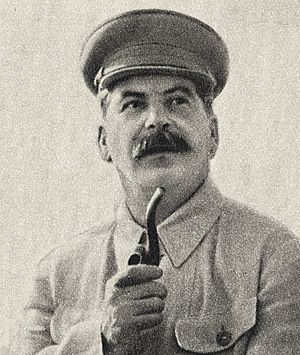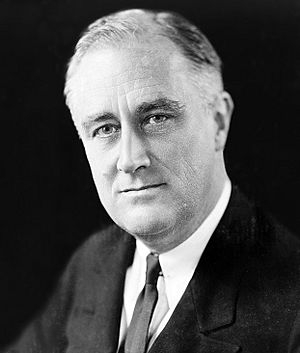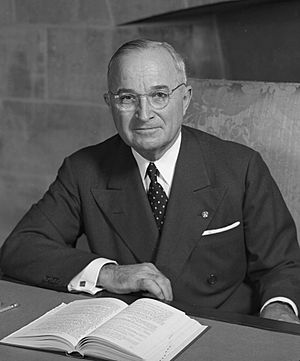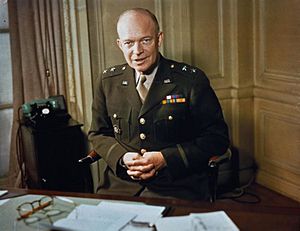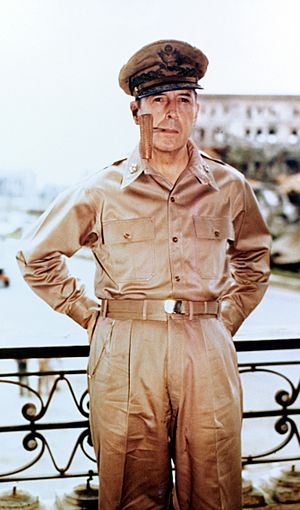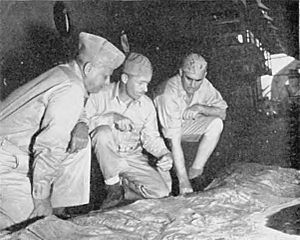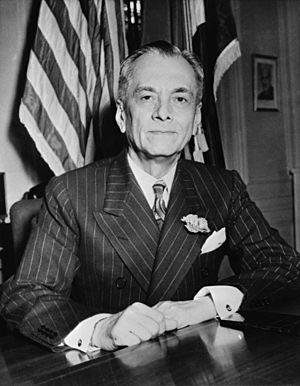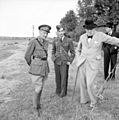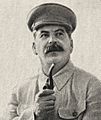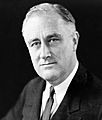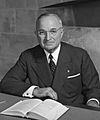Allied leaders of World War II facts for kids
The Allied leaders of World War II were important political and military figures. They led or supported the Allied countries during World War II. This was a total war, meaning it involved everyone and everything. Leaders had to learn about new types of modern fighting, including battles of minds and economies.
Generalissimo of China Chiang Kai-shek, Roosevelt, and Churchill at the Cairo Conference, 25 November 1943.
US President Franklin D. Roosevelt and British Prime Minister Winston Churchill during the Casablanca Conference, January 1943.
The final leaders of the Allies at the Potsdam Conference in 1945: Clement Attlee, Harry S. Truman, and Joseph Stalin.
Contents
- Leaders of the Allied Nations
- Albania's Fight for Freedom
- Belgium's Wartime Government
- Brazil Joins the Allies
- The British Empire and Commonwealth
- China's Resistance Against Japan
- Cuba's Entry into the War
- Free Czechoslovakia's Government in Exile
- Denmark Under Occupation
- Egypt's Monarchy During WWII
- Ethiopia's Emperor and Allies
- France's Leaders and Resistance
- Greece's Fight for Freedom
- Iran After the Invasion
- Korean Provisional Government
- Liberia's Presidents
- Luxembourg's Government in Exile
- Mexico Joins the Fight
- Mongolia's Wartime Leader
- The Netherlands in Exile
- Norway's Resistance and Exile
- Poland's Fight and Government in Exile
- The Soviet Union's War Effort
- The United States' Leadership
- Yugoslavia's Resistance Leaders
- See Also
- Images for kids
Leaders of the Allied Nations
Albania's Fight for Freedom
- Enver Hoxha was the leader of the Communist Party of Albania. He led the Albanian National Liberation Movement. This group fought against Italian and German control in Albania and Germany.
Belgium's Wartime Government
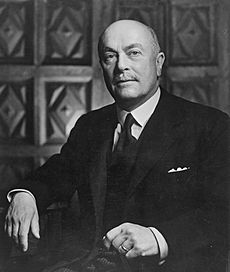
Hubert Pierlot, the prime minister of Belgium between 1939 and 1945, and leader of the Belgian government in exile
- Leopold III of Belgium was the King of the Belgians from 1934 to 1951. He prepared Belgium against invasion. After Belgium surrendered, Leopold stayed in the country. His government, however, went to Great Britain. He was held under house arrest for much of the war.
- Hubert Pierlot was the Prime Minister of Belgium from 1939 to 1945. He became the leader when the war began. Pierlot went to Britain and led the Belgian government in exile. He helped create the Free Belgian forces.
- Pierre Ryckmans was the Governor-General of the Belgian Congo, a large African colony. He brought the Congo into the war on the Allied side. Congolese troops helped British forces in East Africa. The Congo also provided important economic support to the Allies.
- Victor van Strydonck de Burkel was a general in the Belgian Army. After Belgium surrendered in 1940, he became the Commander of Belgian forces in Great Britain. He helped form the Free Belgian forces.
Brazil Joins the Allies
- Getúlio Vargas was the president of Brazil from 1930 to 1945. He ruled as a dictator for part of this time. Even though Brazil had strong ties with Nazi Germany, Vargas joined the Allies. He declared war on Germany and Italy in August 1942 after German submarines sank Brazilian ships. Brazil provided economic and military support, including the Brazilian Expeditionary Force.
- João Baptista Mascarenhas de Morais commanded the Brazilian Expeditionary Force. He led Brazilian troops in Italy from 1944 until the Axis forces there surrendered. He was later made a Field Marshal.
The British Empire and Commonwealth
- King George VI was the King of the British Commonwealth during the war. He was the Commander-in-Chief for countries like the United Kingdom, Canada, and New Zealand. The King and his family visited bombed areas and factories, showing unity during the war.
Australia's Prime Ministers and Generals

Three of Australia's World War II prime ministers – Forde, Curtin and Menzies – plus World War I prime minister Billy Hughes
- Robert Menzies was the Prime Minister of Australia from 1939 to 1941.
- Arthur Fadden briefly replaced Menzies as Prime Minister in 1941.
- John Curtin was Prime Minister from 1941 until his death in 1945. He looked to the US for Australia's safety, especially when facing Japanese attacks. He worked closely with General MacArthur.
- Frank Forde became Prime Minister after Curtin's death but for only a short time in 1945.
- Ben Chifley replaced Forde and served as Prime Minister until 1949.
- Sir Thomas Blamey was the Commander-in-Chief of the Australian Military Forces. He commanded Allied land forces in the South West Pacific from 1942 to 1945. He signed the Japanese surrender for Australia.
Canada's Contribution
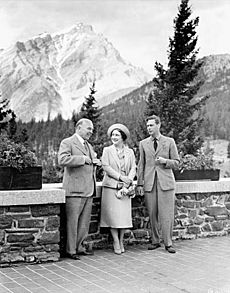
King George VI and Queen Elizabeth with Prime Minister of Canada William Lyon Mackenzie King at the Banff Springs Hotel just prior to the outbreak of war in Europe, 27 May 1939
- William Lyon Mackenzie King was the Prime Minister of Canada during the war. Canada joined the war on its own after Germany invaded Poland.
- Harry Crerar was a general and the main commander of the Canadian military during the war. He led the Canadian military during the Invasion of Normandy.
- Guy Simonds was an army officer who commanded the II Canadian Corps. He led Allied forces to victory in the Battle of the Scheldt.
New Zealand's Leaders
- Michael Joseph Savage was Prime Minister of New Zealand from 1935 until his death in 1940. His government joined Britain in declaring war.
- Peter Fraser became Prime Minister after Savage's death, serving from 1940 to 1949. He led the country during the war, sending supplies and volunteers to support Britain.
- Bernard Freyberg, 1st Baron Freyberg was a Lieutenant General. He led the New Zealand Expeditionary Force in the Battle of Crete, the North African Campaign, and the Italian Campaign.
India's Role in the War
- The Marquess of Linlithgow was the Viceroy of India from 1936 to 1943. He asked the people of India to unite during the war.
- Muhammad Ali Jinnah was a major Muslim political leader. He asked all Indians to join the British Army against Nazi Germany.
- Archibald Wavell, 1st Earl Wavell was in charge of the Middle East Command at the start of the war. He defeated Italian forces in North Africa. He later became Viceroy of India in 1943.
- Claude Auchinleck was appointed Commander-in-Chief, India in 1941. He helped modernize and expand the British Indian Army, which grew to 2,250,000 men by the end of the war.
South Africa's Support
- Jan Smuts was the Prime Minister of the Union of South Africa from 1939 to 1948. He strongly supported the war effort and became South Africa's first Field Marshal in 1941. He helped draft the United Nations Charter after the war.
- George Brink was a lieutenant-general in the South African military. He commanded the 1st Infantry Division during the East African Campaign.
United Kingdom's Key Figures
- Neville Chamberlain was Prime Minister during the first part of the war, from 1937 to May 1940. He had tried to avoid war with Nazi Germany. He resigned after a failed campaign in Norway.
- Winston Churchill was Prime Minister of the United Kingdom for most of the war, from 1940 to 1945. He was against making peace with Germany. His speeches during the Battle of Britain helped boost British morale.
- Clement Attlee was the Labour Party leader and deputy prime minister under Churchill. He was in charge of domestic politics during the war. After the war in Europe, he became Prime Minister in 1945.
- Alan Brooke was the head of Britain's army from 1941 and Churchill's main military advisor. He was promoted to Field Marshal in 1944.
- Bernard Montgomery, 1st Viscount Montgomery of Alamein was a General who led Allied forces in North Africa. He helped defeat the German and Italian forces there. He later commanded Allied ground forces during Operation Overlord, the invasion of Normandy.
- Hugh Dowding, 1st Baron Dowding was an Air Chief Marshal who commanded RAF Fighter Command during the Battle of Britain. He created the "Dowding System," which used radar to defend against air attacks.
- Arthur Harris was an Air Chief Marshal known as "Bomber" Harris. He led the RAF Bomber Command during the latter half of the war.
- Louis Mountbatten, 1st Earl Mountbatten of Burma was Supreme Commander of Allied Forces in South East Asia from 1943 to 1945.
- William Slim, 1st Viscount Slim was a General who led the British Fourteenth Army during the Burma Campaign from 1942 to 1945.
British Malaya's Struggle
- Shenton Thomas was the Governor of Malaya from 1934 to 1942. After the fall of Singapore, he became a prisoner of war.
- Arthur Percival was the General Officer Commanding Malaya at the start of the Pacific War. His surrender at Singapore was the largest in British military history.
Newfoundland's Wartime Governor
- Sir Humphrey Walwyn was governor of Newfoundland from 1936 to 1946. He encouraged Newfoundlanders to join the war effort.
Palestine Under British Mandate
- Harold MacMichael was the High Commissioner of the British Mandate of Palestine from 1937 to 1944.
- Henry Maitland Wilson, 1st Baron Wilson was a Field Marshal who commanded the British Ninth Army in Palestine. He led Allied forces against Vichy France in Syria and Lebanon.
Southern Rhodesia's Prime Minister
- Sir Godfrey Huggins was prime minister of the self-governing colony of Southern Rhodesia from 1933 to 1953.
China's Resistance Against Japan

Generalissimo Chiang Kai-shek.

Generalissimo and Madame Chiang Kai-shek and Lieutenant General Joseph W. Stilwell in Burma in 1942.
- Chiang Kai-shek was the Generalissimo of the National Revolutionary Army and the top political leader of China. He led China into full-scale war with Japan in 1937. When China joined the Allies in 1942, he became the Supreme Commander of the China Theatre, which included Burma.
- Soong Mei-ling was the First Lady of China and Chiang Kai-shek's wife. She helped unite her people against the Japanese. She spoke excellent English and traveled to the United States to gain international support for China.
- He Yingqin was the Chief of the General Staff of China's military. He led the victorious Battle of West Hunan in 1945 and accepted Japan's surrender for China.
- Chen Cheng was a General and one of Chiang's most trusted allies. He commanded forces in several important battles. In 1943, he led the Chinese Expeditionary Force in the Burma campaign.
- Bai Chongxi was a key strategist who convinced Chiang to use a "Total War" approach. He was involved in major campaigns, including the first big Chinese victory at the Battle of Tai'erzhuang.
- Li Zongren was a warlord who allied with Chiang Kai-shek against Japan. He famously won the Battle of Tai'erzhuang, a major Chinese victory.
- Xue Yue was a General known for defending Changsha from Japanese attacks three times between 1939 and 1942.
- Claire Lee Chennault was the commander of the Flying Tigers. He helped set up American squadrons to aid China. The Flying Tigers flew for the Chinese Air Force until 1942.
- Mao Zedong was the Chairman of the Chinese Communist Party. He formed a "United Front" with the Nationalist Government to fight Japan.
- Zhu De was commander-in-chief of the Eighth Route Army and a top military leader for the Chinese Communist Party.
- Peng Dehuai commanded the Hundred Regiments Offensive, the largest Communist attack during the war.
Cuba's Entry into the War
- Fulgencio Batista y Zaldívar was elected President of Cuba in 1940. Cuba declared war on Germany and Italy in December 1941. Batista sent Cuba's navy to fight in the Battle of the Caribbean.
Free Czechoslovakia's Government in Exile
- Edvard Beneš was President of Czechoslovakia and later led the Czechoslovak Government-in-Exile.
- Ludvík Svoboda led Czechoslovak military units on Eastern front against Germany.
- Karel Klapálek led Czechoslovak units in the defense of Tobruk.
- Karel Janoušek led the Czechoslovak air force in Great Britain.
Denmark Under Occupation
- Christian X of Denmark was the Danish king from 1912 to 1947.
- Thorvald Stauning was Prime Minister of Denmark from 1929 until his death in 1942.
- Erik Scavenius was Prime Minister of Denmark from 1942 to 1943. He dissolved the Danish government, leading to total German military rule.
Egypt's Monarchy During WWII
- Farouk of Egypt was the King of Egypt.
- Ahmad Mahir Pasha was the Prime Minister of Egypt from 1944 to 1945.
Ethiopia's Emperor and Allies
- Haile Selassie was the Emperor of Ethiopia from 1930 to 1974. Italy had invaded Ethiopia before the war.
- Orde Wingate was a British Army Officer. He commanded the Gideon Force during the East African Campaign. This force helped the British defeat Italian forces and free Ethiopia.
France's Leaders and Resistance
- Albert Lebrun was the last President of the Third Republic. In 1940, he had to accept Germany's surrender terms for France.
- Édouard Daladier was Prime Minister from 1938 to 1940. He led France at the start of the war.
- Paul Reynaud succeeded Daladier as prime minister in 1940. He led France during the Battle of France. He refused to make a separate peace with Germany and resigned.
- Maurice Gamelin commanded the French military in May 1940 but was removed after failing to defend France.
Free French Forces and Provisional Government
- Charles de Gaulle was the leader of the Free French forces. He headed the French government-in-exile after France fell. He strongly opposed working with the Germans. He eventually led the French Army of Liberation.
- Henri Giraud was a rival to de Gaulle. He co-founded the Free French movement but later became second in command.
- Philippe Leclerc de Hauteclocque was a Free French leader who commanded forces in Africa and France. He signed the armistice with Japan for France in 1945.
- Alphonse Juin became chief of staff of the French Army in 1944. He commanded the French Expeditionary Corps in Italy.
- Marie-Pierre Kœnig commanded the French Forces of the Interior, which helped the Allies invade France.
Greece's Fight for Freedom
- George II of Greece was King of Greece from 1935 until his death in 1947. He was pro-British. When Germany invaded Greece, the King and government went into exile in London.
- Ioannis Metaxas was the dictator of Greece from 1936 until his death in 1941. Despite his leanings, he pursued a pro-British policy. He refused an Italian ultimatum in 1940, leading the Greek Army to fight the Italian invasion.
- Emmanouil Tsouderos was the last Prime Minister of Greece during the German invasion. He was also the first and longest-serving prime minister of the Greek government-in-exile.
- Alexandros Papagos was a Greek general who led the Greek Army against Italy and later against the invading German army. He was arrested by occupation authorities and sent to concentration camps.
- Georgios Siantos was the main leader of the National Liberation Front (EAM), Greece's largest resistance group.
- Napoleon Zervas was the leader of the National Republican Greek League (EDES), Greece's second largest resistance group.
- Aris Velouchiotis created and led the Greek People's Liberation Army (ELAS), the country's largest guerrilla force.
Iran After the Invasion
- Mohammad Reza Pahlavi became the Shah (King) of Iran after his father was forced to step down following the Anglo-Soviet invasion of Iran.
- Mohammad-Ali Foroughi was the Prime Minister of Iran during the Shah's abdication. He helped the new Shah.
Korean Provisional Government
- Kim Koo was the President of the Provisional Government of the Republic of Korea from 1940 to 1947.
- Ji Cheong-cheon was the Supreme Commander of the Korean Liberation Army.
Liberia's Presidents
- Edwin Barclay was the President of Liberia from 1930 to 1944.
- William Tubman was the President of Liberia from 1944 to 1971.
Luxembourg's Government in Exile
- Grand Duchess Charlotte was the head of state of Luxembourg.
- Pierre Dupong was Prime Minister of Luxembourg. He led the government in exile after Germany occupied the country.
Mexico Joins the Fight
- Manuel Ávila Camacho was the President of Mexico from 1940 to 1946. Mexico declared war on the Axis powers in 1942 after German submarines sank two Mexican ships. Mexico helped the war effort by providing soldiers and workers to the United States.
- Antonio Cárdenas Rodríguez was the Commander of the Mexican Expeditionary Air Force (FAEM) from 1945. He represented Mexico at the signing of the Japanese surrender.
Mongolia's Wartime Leader
- Khorloogiin Choibalsan was Prime Minister of Mongolia and the general chief commander of the Mongolian armed forces during World War II. His troops defended against Japan in 1939 and helped free Inner Mongolia in 1945.
The Netherlands in Exile
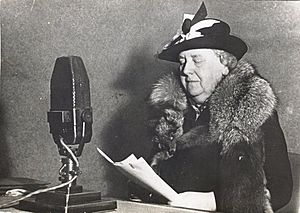
Queen Wilhelmina of the Netherlands gives a radio speech, 1940
- Wilhelmina of the Netherlands was the ruling Queen of the Netherlands. She led the Dutch government in exile from Britain.
- Pieter Sjoerds Gerbrandy was Prime Minister of the Netherlands from 1940 to 1945. He was appointed by Queen Wilhelmina in London.
- Henri Winkelman was Commander-in-chief of the Armed forces of the Netherlands during the Battle of the Netherlands. He was captured and held for the rest of the war.
- Conrad Helfrich was Vice Admiral of the Royal Netherlands Navy. He signed the Japanese Instrument of Surrender for the Dutch government in 1945.
Norway's Resistance and Exile
- Haakon VII of Norway was King of Norway from 1905 to 1957. After the German invasion in 1940, he refused German demands and went into exile in London.
- Johan Nygaardsvold was Prime Minister during the war. His government also went into exile in London.
- Otto Ruge was Chief of Defence of Norway from May to June 1940, leading Norwegian forces in the Norwegian Campaign. He was arrested and sent to Germany.
- Carl Gustav Fleischer commanded the Norwegian 6th Division. He led the recapture of Narvik in 1940, the first major Allied victory against the Germans.
Poland's Fight and Government in Exile
- Ignacy Mościcki was President of Poland from 1926 to 1939. After the Invasion of Poland, he went into exile.
- Edward Rydz-Śmigły was Marshal of Poland and commander of the Polish armed forces during the invasion of Poland.
- Henryk Sucharski was a major in the Polish Army. He commanded the defense of Westerplatte for seven days against overwhelming odds at the start of the war.
Polish Government in Exile and Secret State
- Władysław Raczkiewicz was the President of the Polish Government in Exile from 1939 until his death in 1947. He established the government in exile in London.
- Władysław Sikorski was Prime Minister of the Polish Government in Exile and commander of the Polish Armed Forces. He worked to restore relations between Poland and the Soviet Union. He died in a plane crash in 1943.
- Stanisław Mikołajczyk succeeded Sikorski as Prime Minister, serving from 1943 to 1944.
- Władysław Anders was a Polish General who commanded the II Corps. After being captured by the Red Army, he was released and led the Polish Armed Forces in the East.
- Tadeusz Bór-Komorowski commanded the Home Army during the Warsaw Uprising.
- Stanisław Maczek was a Polish commander who was never defeated in battle. He led the 1st Armoured Division (Poland) from the Normandy landings to the end of the war.
- Stanisław Sosabowski commanded the Polish 1st Independent Parachute Brigade, which fought bravely at Arnhem.
The Soviet Union's War Effort
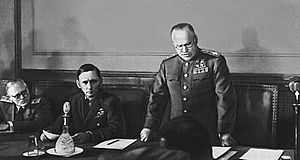
Marshal Zhukov reading the German capitulation. Seated on his right is Air Chief Marshal Arthur Tedder.
- Joseph Stalin was the top leader of the Soviet Union during World War II. He was also the supreme commander of the Red Army. Stalin led the Red Army to free the Soviet Union from Nazi occupation. After the war, he helped set up communist governments in Eastern Europe.
- Georgy Zhukov was a Soviet Field Marshal who led the Red Army to free the Soviet Union. He also led the Soviets in taking much of Eastern Europe and capturing Berlin, Germany's capital.
- Nikolay Gerasimovich Kuznetsov was Admiral of the Soviet Navy. He was responsible for keeping the Nazis out of the Black Sea and the Caucasus. He put his navy on high alert just before the German invasion, making them the only prepared branch of the Soviet military.
- Vyacheslav Molotov was Foreign Minister of the Soviet Union from 1939 to 1949. He signed an agreement with Germany before the war. After Hitler attacked, Molotov worked to form alliances with Britain and the United States.
- Vasily Chuikov commanded the 62nd Army, which defended Stalingrad during the crucial Battle of Stalingrad.
- Ivan Konev led the Red Army on the Eastern Front and helped free much of Eastern Europe. He also helped capture Berlin.
- Konstantin Rokossovsky was made Marshal of the Soviet Union for planning Operation Bagration, a major Soviet offensive.
The United States' Leadership
- Franklin D. Roosevelt was the 32nd President of the United States, from 1933 until his death in 1945. Before the attack on Pearl Harbor, he tried to help the Allies without declaring war. He died two weeks before Germany surrendered.
- Harry S. Truman was the 33rd President of the United States from 1945 to 1953. He became President after Roosevelt's death. President Truman ordered the use of atomic bombs in 1945 to end the war.
- William D. Leahy was the Chief of Staff to the Commander in Chief and the highest-ranking US military officer during World War II. He was a major decision-maker during the war.
- George Marshall was General of the Army and the Chief of Staff during the war. He oversaw the largest military expansion in American history and coordinated Allied operations. After the war, he led the reconstruction effort in Europe, known as the Marshall Plan.
- Henry H. Arnold was a General who commanded the U.S. Army Air Forces during World War II.
- Ernest King was Commander in Chief of the United States Fleet and Chief of Naval Operations.
- Henry L. Stimson was Secretary of War from 1940 to 1945. He was in charge of organizing America's war effort, including raising and training millions of soldiers. He also oversaw the development and use of the atomic bomb.
- Cordell Hull was Secretary of State from 1933 to 1944. He was responsible for foreign relations. He helped establish the United Nations after the war.
- William J. Donovan was the director of the Office of Strategic Services (OSS), which collected intelligence for the US military and government.
- J. Edgar Hoover was the director of the Federal Bureau of Investigation (FBI). He was responsible for intelligence in the United States and South America and successfully stopped a Nazi spy network in the US.
European and North African Front Commanders
- Dwight D. Eisenhower known as "Ike," was the Supreme Commander of the Allied forces in Europe. He planned and oversaw the liberation of France and the invasion of Nazi Germany. He later became president of the United States.
- Omar Bradley was General of the Army in North Africa and Europe. He led the First United States Army during Operation Overlord and the invasion of Europe.
- Mark W. Clark was the Allied commander in the Italian Campaign. He led Allied forces through the invasion of Italy and the capture of Rome in 1944.
- George S. Patton was one of the United States' leading generals in North Africa, Sicily, France, and Germany. He was known as "Old Blood and Guts."
- Carl Andrew Spaatz was the overall commander of the USAAF in the European Theater of Operations.
Pacific Front Commanders
- Douglas MacArthur, General of the Army, was Supreme Commander of Allied Forces in the South West Pacific Area from 1942 to 1945. He accepted Japan's surrender in 1945.
- Chester W. Nimitz, Fleet Admiral, commanded the United States Pacific Fleet and became supreme commander of Allied forces in the Pacific Ocean Area from 1942 to 1945.
- Holland Smith was a general in the United States Marine Corps. He is sometimes called the "father" of modern US amphibious warfare. He led American forces in major campaigns like those in the Aleutians, Gilberts-Marshalls islands, Saipan, and Iwo Jima.
- Joseph Stilwell was a general who served as Chiang Kai-shek's chief of staff and commander of all US forces in China, Burma, and India.
- William Halsey Jr. was a Fleet Admiral who commanded the United States 3rd Fleet and fought in the Guadalcanal campaign and the Battle of Leyte Gulf.
- Raymond A. Spruance commanded United States Navy forces at both the Battle of Midway and the Battle of the Philippine Sea.
- Curtis LeMay was a general in the United States Air Force. He led a strategic bombing campaign in the Pacific theater.
- William S. Parsons was an American admiral who worked on the Manhattan Project. He was the weaponeer on the Enola Gay aircraft that dropped the atomic bomb on Hiroshima.
- Paul Tibbets was a United States Air Force general who flew the Enola Gay over Hiroshima.
- Alexander Vandegrift was a United States Marine Corps general who commanded forces at the Battle for Henderson Field.
Puerto Rico's Contributions
- Rexford Tugwell, served as the last appointed American Governor of Puerto Rico from 1941 to 1946. He supported Puerto Rican self-government.
- Pedro del Valle, was a highly decorated Marine lieutenant general. He played a key role in the Guadalcanal Campaign and the Battle of Guam. He became the Commanding General of the First Marine Division.
- Juan César Cordero Dávila, was a brigadier general who commanded the 65th Infantry Regiment (United States), a Puerto Rican unit, in Europe during World War II.
The Philippines' Presidents
- Manuel L. Quezon was the first Filipino president of the Commonwealth of the Philippines. He was evacuated to Washington, D.C., after the Japanese invasion and died there in 1944.
- Sergio Osmeña was the second Filipino president of the Commonwealth of the Philippines. He became president after Quezon's death in 1944. He returned to the Philippines with General Douglas MacArthur during the liberation.
- Basilio J. Valdes was the commanding general of the Philippine Commonwealth Army. He was evacuated to Washington, D.C., and returned with General MacArthur.
Yugoslavia's Resistance Leaders
- Peter II was the last King of Yugoslavia from 1934 to 1945. He opposed Nazi Germany and was forced to leave the country after the Axis invasion. He later agreed to share power with Josip Broz Tito.
- Draža Mihailović was the leader of Chetniks, a royalist resistance movement. He was supported by the exiled royal government for a time.
- Josip Broz Tito was a leader of the Yugoslav Partisans resistance movement, which was the largest in Europe. He gathered widespread support against fascism. With help from Soviet forces, the Partisans freed Yugoslavia.
See Also
- Allies of World War II
- Axis leaders of World War II
- Commanders of World War II
- Neutral powers during World War II
- Opposition to World War II
Images for kids

All content from Kiddle encyclopedia articles (including the article images and facts) can be freely used under Attribution-ShareAlike license, unless stated otherwise. Cite this article:
Allied leaders of World War II Facts for Kids. Kiddle Encyclopedia.

